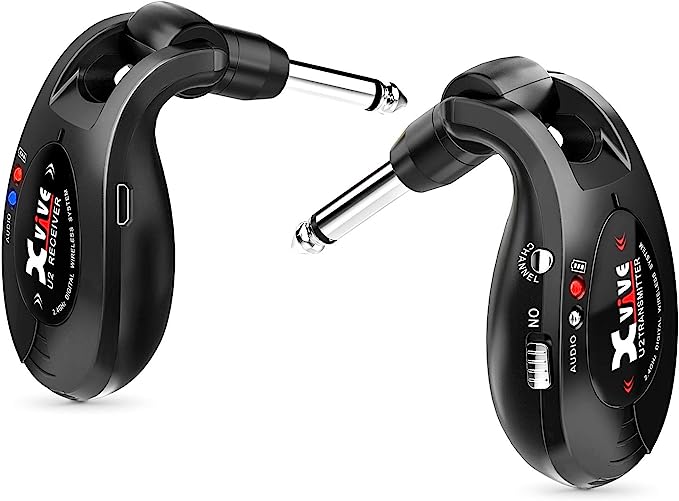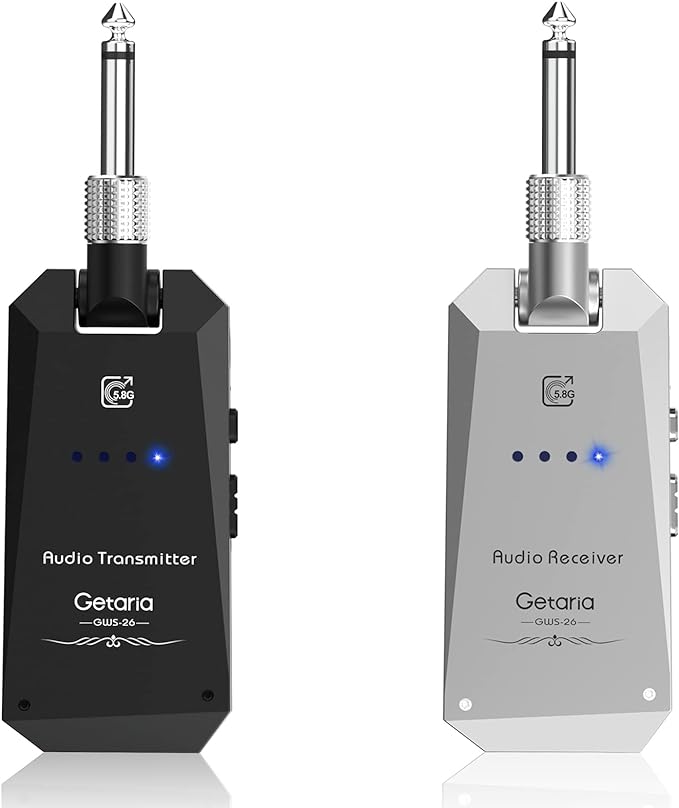As a seasoned musician and tech enthusiast, I’ve witnessed firsthand the transformative impact of wireless technology in the guitar world.
Through this article, I aim to demystify the array of options available. Drawing from my extensive experience, I’ll provide in-depth reviews of the leading systems, a detailed buying guide, and answers to common queries. Whether you’re rocking out on a grand stage or fine-tuning your skills at home, the perfect wireless system can elevate your musical journey.
Pros
- Exceptional sound quality with no noticeable latency.
- Simple plug-and-play functionality.
- Long battery life and easy recharging.
- Robust build quality suitable for touring musicians.
- Versatile for use with a wide range of instruments.
Cons
- Non-removable battery, though longevity has not been an issue.
As a musician always on the lookout for gear that enhances performance without compromising sound quality, I recently had the opportunity to test the Xvive U2 Guitar Wireless System. This compact, rechargeable system operates at 2.4GHz, promising crystal-clear audio transmission with minimal latency. After using it extensively, here’s my detailed review:
Product Overview
- System Components: Includes a transmitter, receiver, and a USB cable for charging.
- Frequency Range: Delivers a full 20Hz – 20kHz frequency response.
- Latency: Impressively low at under 6ms.
- Range: Offers over 70 feet of coverage, ideal for large stages.
- Battery Life: Up to 5 hours on a single charge.
- Build: Durable ABS plastic, suitable for touring and various climates.
- Compatibility: Works well with different guitar and bass types.
Using the Xvive U2 was a revelation in wireless performance. Its ease of setup and use right out of the box was a major plus. The system paired flawlessly with my Fender Telecaster and a variety of other instruments, including a Danelectro 12-string and a Godin Bass, showcasing its versatility.
The sound quality was exceptional, with no noticeable difference from a traditional cable connection. The freedom to move around the stage without worrying about tripping over cables was exhilarating. Additionally, the system’s ability to resist interference and maintain a stable connection was commendable, even in environments with numerous other wireless devices.
Pros
- Clear sound quality with minimal latency.
- Long-range, ideal for large stages.
- Supports multiple devices on 4 channels.
- Compact and easy to use.
Cons
- Some users reported occasional issues with the receiver’s responsiveness.
The Getaria Wireless Guitar System is a 5.8GHz transmitter and receiver set designed for electric guitars and basses. It offers a stable, clear signal over a range of up to 100 feet. Key features include less than 5.6ms latency, compatibility with various instruments, and the ability to support multiple devices simultaneously on 4 channels.
Upon testing the Getaria system, I was immediately impressed with its easy setup and reliable performance. The low latency ensured seamless play, and the sound quality remained consistent whether I was close to the receiver or at the far end of its range. It was particularly useful in busy environments where multiple wireless systems were in use, thanks to its 5.8GHz frequency that effectively minimized interference.
Pros
- Clear sound quality.
- Long battery life.
- Supports multiple devices simultaneously.
- 280° rotatable plug for easy connection.
Cons
- Some users may prefer a longer battery life for extended sessions.
The Getaria Upgrade 2.4GHz Wireless Guitar System features a built-in rechargeable lithium battery, offering a long working duration with a convenient USB cable for recharging. It supports 6 sets of devices simultaneously without interference, and the transmitter can also transmit to several receivers at once. The 280° rotatable 1/4″ plug accommodates different instrument jack positions.
I found the Getaria Upgrade system to be a highly efficient tool for wire-free playing. The rotatable plug design is particularly useful for guitars with varying jack positions. The sound transmission is crystal clear, and the ability to connect multiple devices without interference is a great feature for band rehearsals or multi-instrument setups.
Buying Guide: Choosing the Best Wireless Guitar System in 2023
When selecting the best wireless guitar system, consider factors like frequency response, range, battery life, and compatibility. Look for systems with low latency to ensure real-time audio transmission. Frequency range is crucial for sound fidelity, and a good system should support full spectrum audio from 20Hz to 20kHz. Range is important for stage performance; a system offering 70 feet or more is ideal. Battery life impacts usability; longer battery life means less frequent charging. Lastly, check compatibility with your instruments and other gear. This guide will help you find the best wireless guitar system to meet your musical needs and enhance your performance experience.
- Frequency Response and Range: The frequency response of a system determines the quality of sound it can reproduce. Look for a system that offers a full spectrum response, typically from 20Hz to 20kHz, to ensure the best sound quality. Additionally, the operating range of the system is crucial, especially for live performances. A range of 70 feet or more is generally considered good for stage use.
- Latency: Low latency is critical for real-time audio transmission. The lower the latency, the less delay you’ll experience between playing a note and hearing it through the amp. This is particularly important for live performances and recording.
- Battery Life: Consider the battery life of the system. Longer battery life is more convenient and ensures that you can use the system for extended periods without the need for frequent recharging.
- Build Quality and Durability: Durability is key, especially for touring musicians. Look for systems made with robust materials that can withstand the rigors of travel and frequent use.
- Compatibility: Ensure that the system is compatible with your instruments and other audio equipment. Some systems are designed specifically for certain types of guitars or basses.
- Ease of Use: A user-friendly system that is easy to set up and operate can save you a lot of time and hassle, especially in live performance situations.
- Interference and Stability: A good wireless system should be able to resist interference from other wireless devices and provide a stable connection throughout its range.
- Price and Value: Finally, consider the price and the value you’re getting for it. The most expensive option isn’t always the best, but investing in a quality system can save you money and frustration in the long run.
FAQ
What is the ideal frequency range for a wireless guitar system?
The best wireless guitar systems typically offer a full frequency response from 20Hz to 20kHz, ensuring the highest sound quality and fidelity.
How important is latency in a wireless guitar system?
Low latency is crucial for real-time audio transmission, especially during live performances. Systems with low latency provide a seamless playing experience.
Can wireless guitar systems work with all types of guitars?
Most systems are designed to be compatible with a variety of guitars, but it’s important to check the specific compatibility with your instrument model.
What is a good battery life for a wireless guitar system?
A good system should offer several hours of playtime. Ideally, look for a system with a battery life of at least 5 hours to ensure uninterrupted performance.
Are wireless guitar systems prone to interference from other devices?
Quality wireless guitar systems use frequencies like 2.4GHz or 5.8GHz to minimize interference, but it’s always wise to check the system’s ability to resist interference in crowded frequency environments.




